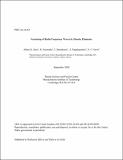| dc.description.abstract | The edge region and the scrape-off layer of magnetically confined fusion devices, like tokamaks and stellarators, are replete with turbulent plasma that is a mixture of coherent, blob or filament like, structures [1] and incoherent fluctuations [2]. The variation in the density due to turbulence can be comparable to or greater than the ambient density [2]. As part of an overall effort to optimize the efficiency of operation, radio frequency (RF) waves are commonly used for heating fusion plasmas and, in tokamaks, for generating plasma current needed for confinement and controlling instabilities. The RF waves are excited by antenna structures that are placed near the wall of a fusion device. In order to deliver energy and momentum to charged particles in the core of fusion plasmas, RF waves have to propagate through the turbulent plasma. In present fusion devices, the scrap-off layer and the edge plasma region is of the order of a few centimeters. In reactor type devices, like ITER, this region is expected to be of the order of tens of centimeters. Since the efficiency of operation of a fusion reactor is of prime importance, it is imperative that we understand the effect of turbulence on RF waves. The fluctuations in density lead to changes in the plasma permittivity. As in conventional electrodynamics, the propagation of RF waves through different dielectric media is subject to reflection, refraction, and diffraction. In this paper, we summarize our theoretical and computational studies on the propagation of RF waves through filamentary structures present in the scrape-off layer. | |
